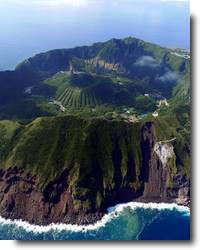Shodoshima 小豆島
I boarded a ship named the Olive Maru, of the Olive Line Ferry. When we docked, I caught the Olive Liner bus to the town of Nishimura. That is where the olives grow.
On the side of the hill rising out of the bay, stood a Greek-styled fade. In the central atrium, a towering Athena watched busloads of tourists being conducted briskly through her tiny museum, and then, of course, on to the gift shop.
There, they grabbed up olive chocolates, olive soap, olive cosmetics, olive bath salts, black olives in tins and green olives in jars. They eyed the bottles of olive oil suspiciously, asking each other, "Why does it say 'virgin' on the label? What do virgins have to do with olive oil?" They bought them anyway, because they had come to Shodoshima.
The Seto Inland Sea is called Japan's Agean, and little Shodoshima has been dubbed her "Olive Island". (Read about another island in the Seto Inland Sea, Naoshima.)
Passing up a night at the Hotel Olivian, a sprawling complex of spa and sport facilities, ultra luxurious accommodations, and fine restaurants, I slept at the Olive Youth Hostel, and walked along the shores of Olive Beach. Even the city garbage bags were printed with a sketch of olives ripening on the branch.
With all this olive consciousness, you might think that olives, themselves would be a prominent feature of life in Nishimura. Olives are, for example, food. So I imagined some sort of olive cuisine on every restaurant menu in town.
My first challenge was to find the restaurants. The people of Shodoshima are generally friendly and helpful. It would be unusual if you actually had to ask for directions on the island. Just look unsure about where you are going, and there will be someone at your elbow telling you how to get to the nearest sightseeing spot. But even lifelong residents of Nishimura will cock their heads and suck their teeth, dumbfounded, if you ask after a good place for lunch.
The Sun Olive Spa, to the right of the psuedo-greek monument, has a small restuarant inside. At six o'clock they break out the dinner menu: curry rice and bentos. In the center of town there are two noodle shops: one for udon, one for numen. Their menus make no mention of olives.
Olives on Shodoshima
To be fair, olives do show up in the role of accents. The house specialty at Sun Olive Spa included sea bream doused with olive oil. There was one tiny, batter fried manzanilla tucked into the tempura at the numen restaurant. I was chastised by a waiter at the Hotel Olivean because I did not order bread with my dinner. It is served, he explained, with an accompanying dish of olive oil into which one dips the bread instead of spreading it with butter.
"This," he said, as he poured it out, "is virgin olive oil, so you can drink it."
But, outside of the gift shop, it is rare to find an olive that is not growing on a tree. Although there are plenty of those. To the left of the monument, the hill is covered with an olive grove, and it is lovely to walk there. You can look out over the tops of the green and silver leafed trees, and the surface of a clear watered sea, to a horizon bursting with little islands that crowd in on one another as they fade off into the mist. You really get the feeling of being on an archipelago.
During the growing season, you can see the olives in all their colorful stages of ripening, from yellowish green to royal purple to deep, reddish black, but what are they ripening for? Come in the fall, and you will see them fallen, unharvested, to the ground, where they remain to be crushed underfoot until they are swept up by gardeners.
There is a clue at the heart of the grove: an old grandmother of a tree. A stone signpost proclaims her as progenitor of olive trees on the island. If you know your olives (or if you turn around after paying your respects to the First Tree and read the other sign) you will see that the olives in this grove are manzanillas, a hardy variety native to Spain, not Greece.
Olive Oil & The Fishing Industry
If you think there is something fishy here, then you are more right than you may know. Open a tin of sardines and you'll see why. Oil is used to pack fish. It was not for the sake of the palate, nor aesthetics, nor internationalism. It was for its fishing industry that the Japanese government decided, to produce its own oil rather than buy it from other countries.
Shodoshima 小豆島
I boarded a ship named the Olive Maru, of the Olive Line Ferry. When we docked, I caught the Olive Liner bus to the town of Nishimura. That is where the olives grow.
On the side of the hill rising out of the bay, stood a Greek-styled fade. In the central atrium, a towering Athena watched busloads of tourists being conducted briskly through her tiny museum, and then, of course, on to the gift shop.
There, they grabbed up olive chocolates, olive soap, olive cosmetics, olive bath salts, black olives in tins and green olives in jars. They eyed the bottles of olive oil suspiciously, asking each other, "Why does it say 'virgin' on the label? What do virgins have to do with olive oil?" They bought them anyway, because they had come to Shodoshima.
The Seto Inland Sea is called Japan's Agean, and little Shodoshima has been dubbed her "Olive Island". (Read about another island in the Seto Inland Sea, Naoshima.)
Passing up a night at the Hotel Olivian, a sprawling complex of spa and sport facilities, ultra luxurious accommodations, and fine restaurants, I slept at the Olive Youth Hostel, and walked along the shores of Olive Beach. Even the city garbage bags were printed with a sketch of olives ripening on the branch.
With all this olive consciousness, you might think that olives, themselves would be a prominent feature of life in Nishimura. Olives are, for example, food. So I imagined some sort of olive cuisine on every restaurant menu in town.
My first challenge was to find the restaurants. The people of Shodoshima are generally friendly and helpful. It would be unusual if you actually had to ask for directions on the island. Just look unsure about where you are going, and there will be someone at your elbow telling you how to get to the nearest sightseeing spot. But even lifelong residents of Nishimura will cock their heads and suck their teeth, dumbfounded, if you ask after a good place for lunch.
The Sun Olive Spa, to the right of the psuedo-greek monument, has a small restuarant inside. At six o'clock they break out the dinner menu: curry rice and bentos. In the center of town there are two noodle shops: one for udon, one for numen. Their menus make no mention of olives.
Olives on Shodoshima
To be fair, olives do show up in the role of accents. The house specialty at Sun Olive Spa included sea bream doused with olive oil. There was one tiny, batter fried manzanilla tucked into the tempura at the numen restaurant. I was chastised by a waiter at the Hotel Olivean because I did not order bread with my dinner. It is served, he explained, with an accompanying dish of olive oil into which one dips the bread instead of spreading it with butter.
"This," he said, as he poured it out, "is virgin olive oil, so you can drink it."
But, outside of the gift shop, it is rare to find an olive that is not growing on a tree. Although there are plenty of those. To the left of the monument, the hill is covered with an olive grove, and it is lovely to walk there. You can look out over the tops of the green and silver leafed trees, and the surface of a clear watered sea, to a horizon bursting with little islands that crowd in on one another as they fade off into the mist. You really get the feeling of being on an archipelago.
During the growing season, you can see the olives in all their colorful stages of ripening, from yellowish green to royal purple to deep, reddish black, but what are they ripening for? Come in the fall, and you will see them fallen, unharvested, to the ground, where they remain to be crushed underfoot until they are swept up by gardeners.
There is a clue at the heart of the grove: an old grandmother of a tree. A stone signpost proclaims her as progenitor of olive trees on the island. If you know your olives (or if you turn around after paying your respects to the First Tree and read the other sign) you will see that the olives in this grove are manzanillas, a hardy variety native to Spain, not Greece.
Olive Oil & The Fishing Industry
If you think there is something fishy here, then you are more right than you may know. Open a tin of sardines and you'll see why. Oil is used to pack fish. It was not for the sake of the palate, nor aesthetics, nor internationalism. It was for its fishing industry that the Japanese government decided, to produce its own oil rather than buy it from other countries.



Comentários